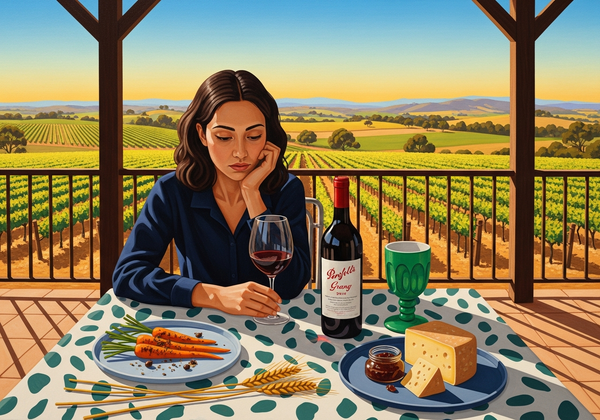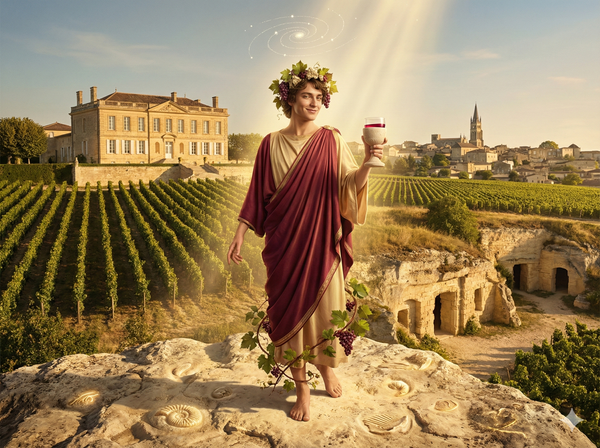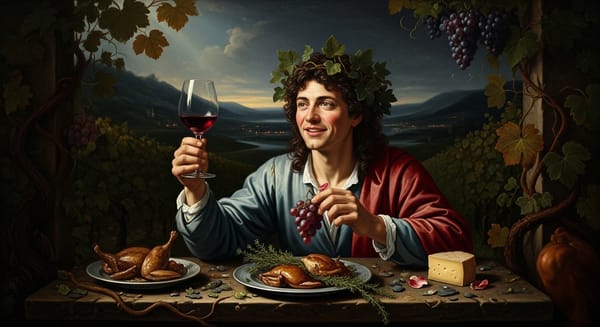Stone, Sky, and a River’s Patience: Ribera del Duero in Three Acts
Ribera del Duero wine guide: high-altitude Tinto Fino (Tempranillo) shaped by the Duero River and clay-limestone/gravel soils. Clear DO aging—Crianza, Reserva, Gran Reserva—plus classic pairings (lechazo asado), serving/cellaring tips, and key estates told as a moonlit ramble.

Three Sips to Start
Late light drifts across the Castilian plateau and the Duero moves as if careful not to wake the banks. Heat lets go in layers; a cold seam opens behind it. In a single glass I find dark fruit edged with graphite, violets folded into cedar, and a kind of altitude-bought calm that makes time feel wider.
From Cloisters to Cult Bottles
Monks, Cellars, and a Long Quiet
In old stone, there are fingerprints of Cistercian patience. Centuries ago, robed hands kept their own weather underground—barrels sleeping in cellars cool enough to remember winter. The river was a whisper then, not a brand; vines a way to turn hard sun and cold nights into something that could be carried, shared, stored. The centuries in between didn’t always speak loudly, but they spoke steadily: a countryside that kept the craft even when the world forgot to ask.
1982 and the Turning of the Page
The year the Denominación de Origen seal arrived, the region inherited a new responsibility: to name itself and defend that name. The letters were a frame, not a promise; the promise would come from the plateau—its height, its winds, its uncompromising seasons—and from the growers who learned to listen to both.
The Past, Poured
What remains from those beginnings is humility before climate and an instinct for custody. Ribera del Duero does not chase density for its own sake; it asks tannin to show its grain and fruit to hold its line. The best bottles taste as if someone was paying attention—to the frost that steals a morning, to the hail that can redraw a harvest, to the river that gives and withholds in equal measure.
Maps, Not Medals
What DO Says (and Doesn’t)
A Denominación de Origen tells you where and how. It binds vineyards to a geography and a method—authorized grapes, rules for aging, basic guarantees of identity. It does not rank wines by virtue of the seal alone, nor demand a single house style. Think of it as coordinates for finding your way back to a flavor that felt honest.
Aging, Uncloaked (Explicit Definitions, Plain Language)
Ribera del Duero red wines use the national aging categories, interpreted through the region’s lens:
- Crianza — Minimum 24 months of total aging, at least 12 months in oak, with the balance typically resting in bottle. In the glass: fruit still forward, tannins firm but conversational; a thread of spice beginning to stitch edges together.
- Reserva — Minimum 36 months total, at least 12 months in oak, the rest in bottle. Expect darker fruit and a longer arc: cedar, tobacco leaf, and the feeling that time has sanded corners from grit to silk.
- Gran Reserva — Minimum 60 months total, at least 24 months in oak, and extended bottle repose. Aromatics turn architectural: incense, dried flowers, leather and saffron; structure becomes a quiet engine rather than a loud machine.
These are timelines written into law, but their purpose is tactile, not bureaucratic: to give tannin time to learn good manners and let fruit speak in paragraphs rather than headlines.
Altitude, River, and the Big Daily Sigh
Thin-Air Advantage (~700–900+ m)
Vines grow high here, on a plateau where summer afternoons can glare and midnights can bite. That elevation buys diurnal swing: acids hold while sugars rise; skins thicken; aromatics sharpen; tannins etch finer. Tinto Fino tastes like a wine that breathes mountain air—even when the day was hot, the night remembered snow.
Bones of the Valley (Clays, Limestone, Gravels)
Clay-limestone benches give straight-backed wines with graphite and poise; alluvial gravels near the river lend sleekness and a cool, stony line; sandier pockets soften the middle and perfume the nose. Move a few steps and the conversation shifts—tannin changes from velvet to chalk, fruit from black cherry to sloe, spice from bay leaf to anise.
The Duero’s Edge (Terraces & Cold Nights)
Terraces rise and fall along the river like shelves of memory. Cold pools in the hollows after sundown, then drains before dawn. The effect is composure: heat paints the fruit; night sharpens the outline; the current under everything is freshness.
Heat by Day, Nerve by Night (Diurnals)
There’s a rhythm you can taste—sun gives generosity, night returns control. The best bottlings keep both: breadth without blur, detail without thinness. A kind of inland sea breeze you feel rather than feel named.
Tinto Fino & Its Choir
The Local Name for an Old Soul (Tempranillo)
Tinto Fino—also called Tinta del País—is Tempranillo with a plateau accent. Skins a touch thicker, clusters compact, berries eager to hold their shape. It brings black cherry and blackberry, violets and licorice, and tannins that can seem stern until patience translates them into structure. In Ribera, Tinto Fino is more protagonist than theme; the story is told in its voice.
Small Harmonies (Cabernet, Merlot, Malbec, Garnacha)
Permitted partners step in with restraint when a wine needs contour or lift. Cabernet supplies spine and a pencil-line of graphite; Merlot pours warmth across the middle; Malbec deepens color and bass notes; Garnacha can add a red-fruited gleam. The blends remain Ribera at their core—altitude-bred clarity first, adornment second.
A Pale Whisper Returns (Albillo Mayor)
There is also a hush at the edges: Albillo Mayor, once part of field blends, now recognized for whites that smell of pear skin, chamomile, and a dusting of almond. The volume is low; the intent is honest. On days when heat crowds the red side of the cellar, Albillo reads like shade.
Aromas Without Cliché
Think black cherry, blackberry, sloe and plum; violets pressed between pages; licorice and clove; cedar shaving and cigar leaf as age moves in; sometimes a thread of saffron where the soils run pale. Texture matters as much as flavor: the plateau teaches tannin to stand tall but speak softly.
How to Pour the Plateau (Serving & Cellaring—Classic Only)
Where the Glass Should Live
Red Ribera shows best at 60–64 °F (15–18 °C)—cool enough to keep edges clean, warm enough to let spice rise. Younger wines appreciate a 60–90 minute decant to lengthen the stride; mature bottles prefer courtesy: stand them up a day, then decant gently just before serving.
Breathing Room (Youth vs. Mature)
For crianzas full of energy, decanting is a stretch before a run. For reservas and gran reservas with decades folded into them, use a narrower carafe and a softer hand; the goal is not oxygen as drama but oxygen as diction.
At the Table (Lechazo, Grills, Winter Stews)
Lechazo asado—cast-iron roast lamb with salt and nothing else—meets Ribera’s tannin like a handshake you trust. Chuletillas a la brasa (little lamb chops over vine-prunings) echo smoke and spice. Winter stews—chorizo, chickpeas, paprika—invite the wine’s dark fruit to read as comfort rather than weight. Morcilla de Burgos adds savory gravity that makes the finish feel longer.
How Long to Wait (Broad Windows)
Well-made crianzas can sing from 6–10 years, depending on balance; reservas often open widest from 8–15; gran reservas—when line and fruit are true—comfortably stride past 15–30+. The right night is not a number but a conversation where the bottle speaks more than you do.
Hands, Barrels, and the Sky (Winemaking Philosophy)
Vines That Remember
Old bush-trained vines hold the wind differently than trellised rows. They give fewer clusters, tighter berries, a slower, steadier ripeness. Yields here are measured more in dawns than in tons—each pass through the rows a decision about what to keep, what to let go.
Polish vs. Grit (Extraction Judgment)
Whole berries keep brightness; crushed fruit lends amplitude; cap management becomes a dialect—pump-overs for clarity, punch-downs for grip; longer maceration only if the skins can afford it. The best cellars let tannin show its fingerprint rather than lacquer it smooth.
Oak as Frame (French/American, Finesse First)
American oak once carried a sweet accent—coconut, dill—now used more carefully; French barrels lean toward cedar and toast. The region’s drift is toward finesse: finer grain, calibrated toast, more time in bottle before a label calls itself ready. Oak is frame, not perfume; if it’s doing its job, you sense structure before you smell it.
Farming the Risk (Frost, Hail, Organics)
A plateau this high makes you a student of risk. Frost threatens early, hail in the heat, drought when the year runs lean. Nets, candles, and prayer have all been tried; so have cover crops, compost teas, and living soils. The most serious growers treat the vineyard as an organism that needs resilience more than rescue.
Night Walk Along the Duero: Voices to Know
Moonlight silvers the river and the road bends past low walls and sleeping vines. I taste as I walk: glasses that smell of stone left in the sun, glasses that feel like a page turned with clean hands.
I begin where patience is habit. At Vega Sicilia, nineteenth‑century roots anchor Único, which spends close to a decade between wood and bottle—time used as a tool. Nearby, Alión answers in a modern dialect: pure‑fruited, polished, clarity over decades.
Downriver, Hacienda Monasterio sits between Pesquera and Valbuena, limestone lending lift to organic farming. Peter Sisseck’s Pingus—old vines in La Horra, biodynamic, tiny—whispers loudly; PSI gathers growers into a generous chorus.
Aalto stitches old parcels across villages for proportion; Aalto PS slows the heartbeat. From the eastern zone, Garmón draws 40–80‑year vines into still, focused power.
Under Peñafiel’s castle, Protos—first in 1927—moves with steady cadence from cool, tunneled cellars; across the slope, Pago de Carraovejas rides south‑facing terraces, plot wines etching sharp lines.
In Pesquera de Duero, Emilio Moro’s Malleolus carries tobacco‑toned fruit over stony ground. Valduero waits longer; reservas and gran reservas read like careful letters.
Upriver in La Aguilera, Dominio del Águila tends ancient mixed plantings; reds feel like dusk, and Albillo Mayor lingers like shade.
I stop where the path meets water and finish a glass that smells like warm stone at night. Different hands, same grammar: breadth held by line, fruit held by night, stories held by glass.
Ledger of Sun & Stone (Investment—Philosophical Only)
Scarcity here is not theater; it’s geography and age. Old vines don’t multiply; they survive. Names accumulate cultural weight because they keep their promises; new names rise when they promise less and deliver more. Altitude is a kind of insurance policy in warm years—acids keep a backbone, the nights return a cool hand to the shoulder.
If there’s a thesis, it is that value is a feeling you recognize before you total it. A cellar can be an index of evenings yet to occur. Ribera del Duero bottles are good at arranging those evenings—stretching a table into laughter, taking the sharpness out of an argument, reminding the room that patience is not the same as waiting.
When the Plateau Exhales
Night flattens the fields to a single dark plane and the river keeps its own counsel. Somewhere, a gate clicks, then stills. In the glass, spice leans into fruit and a cedar line draws the last sentence cleanly across the tongue. I walk back toward the village with the kind of quiet you carry rather than break. Tomorrow the sun returns; tonight, the plateau has the last word.





